The names Final Fantasy and especially Final Fantasy VII evoke strong feelings in fans of the venerable series and role playing games in general. So when a new title from Square Enix arrives in that universe, there is a lot to live up to. Thankfully, the story of Zach Fair in Crisis Core – Final Fantasy VII is an amazing one with a top notch game to back it up.
Zach Fair is a little known character shown in cutscenes during the original Final Fantasy VII game on the PS1. He is a friend to Cloud Strife and Aerith’s (Aeris) old boyfriend. Zach was very important to both characters, and in this prequel we are introduced to him and learn how the events in the main universe were shaped and introduced.
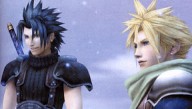 Zach starts the game as a SOLDIER 2nd class operative who is being mentored by the stoic yet noble Angeal, who is notably equipped with FFVII Cloud’s infamous Buster Sword. Immediately, we wonder how and why this sword finds its way to Cloud’s hands, but we have no time to wonder as a typically amazing and epic scale CG cutscene unfolds, introducing us to the look and feel of the game and our hero Zach Fair. The game starts right after the cutscene and is played via a real time engine that is both easy to use and functional.
Zach starts the game as a SOLDIER 2nd class operative who is being mentored by the stoic yet noble Angeal, who is notably equipped with FFVII Cloud’s infamous Buster Sword. Immediately, we wonder how and why this sword finds its way to Cloud’s hands, but we have no time to wonder as a typically amazing and epic scale CG cutscene unfolds, introducing us to the look and feel of the game and our hero Zach Fair. The game starts right after the cutscene and is played via a real time engine that is both easy to use and functional.
Zach begins his journey with one goal in mind; to be a hero. This is his motivation and his dream, and it infuses his character with a nobility and passion that we have never seen before in a lead character in the Final Fantasy series. Over the course of the game, Zach noticeably matures and becomes wiser about the world, his role in it and the realities of the Shinra corporation. It is a compelling tale that is all the more powerful as we know the eventual fate of Zach, since this is a prequel.
The world you are in is alive with people and there are many little back stories and side elements that flesh out the story and your relationship with the characters. E-mail and cell phone calls play a big part in this; you will constantly receive messages or calls adding some info or fleshing out a relationship. This addition of depth and immersion really enhances the tone and solidity of the world you are traveling through
The real winning element in the narrative is the true growth we see in the character interaction, in many other Final Fantasy games you don’t understand why people care about each other. In this title, we see why Zach looks up to Angeal, we understand why he and Cloud are friends and we understand why Aerith misses him. These are real moments and for the first time in the series we have main characters we care about. I actually had a shiver when Angeal said to Zach at one point, “You’re a little more important than my sword, but… just a little.” The sly look and the posture of the character shows that Zach is much more important the Angeal’s famous sword without him having to actually say it.
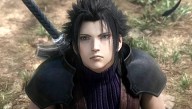 Crisis Core – Final Fantasy VII is a more intimate experience then the other games in the series. Not only do we know the characters better, but the story is at a smaller more personal scale. There is no threat to the world at large, there is no giant meteor on its way, there is no invading humanity destroying army. There is just the story of honor, friendship and loss. I really like how they approached the world with care and restraint. The story is enough to remember why you love the series and why you care about seeing more adventures in this gritty world. It is a refreshing change from the large-scale encounters we usually see and a nice reminder that stories do not need to be epic, they just have to be well told.
Crisis Core – Final Fantasy VII is a more intimate experience then the other games in the series. Not only do we know the characters better, but the story is at a smaller more personal scale. There is no threat to the world at large, there is no giant meteor on its way, there is no invading humanity destroying army. There is just the story of honor, friendship and loss. I really like how they approached the world with care and restraint. The story is enough to remember why you love the series and why you care about seeing more adventures in this gritty world. It is a refreshing change from the large-scale encounters we usually see and a nice reminder that stories do not need to be epic, they just have to be well told.
In order to have an engaging game around these events and stories, Square Enix took inspiration from a number of sources, notably their Kingdom Hearts franchise. Crisis Core is an action oriented RPG that is a real time game in every aspect: you walk on the maps, and as you encounter random creatures, they appear on the plain with you without any transition to a separate battle screen. At your disposal are a large number of abilities that are pulled from the Materia you are equipped with. If you equip Thunder, Fire, Cure or other Materia types, they are added to your list of available commands. The L and R shoulder buttons cycle through the pre-installed actions and your attack button activates the spell or action. The circle button defaults you back to a standard strike attack option so in a pinch so you can easily get your job done. It is a great way to implement a deep combat system in a simple and effective package.
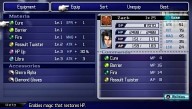 This is how you perform your regular actions, but choosing and equipping the Materia and accessories can be a very in-depth process as well. Not only are there dozens of normal Materia you can find through battles or exploration, but you can fuse Materia together to make more powerful versions. Equipped Materia gains levels up to a cap and the same Materia may have different beneficial side effects. Add to this the fact that you can also fuse accessories and materials with the Materia to make unique ones that further add to the depth of this game’s ability system. I found myself on more then one occasion getting lost in the fusion process for over an hour just playing around and seeing what combinations I could make to better my character.
This is how you perform your regular actions, but choosing and equipping the Materia and accessories can be a very in-depth process as well. Not only are there dozens of normal Materia you can find through battles or exploration, but you can fuse Materia together to make more powerful versions. Equipped Materia gains levels up to a cap and the same Materia may have different beneficial side effects. Add to this the fact that you can also fuse accessories and materials with the Materia to make unique ones that further add to the depth of this game’s ability system. I found myself on more then one occasion getting lost in the fusion process for over an hour just playing around and seeing what combinations I could make to better my character.
Another innovation in this game is the Digital Mind Wave (DMW) feature in the game. Crisis Core is a solitary adventure. There is no party following you and entering battle by your side, but Square Enix obviously wanted you to meet many characters and have benefits by knowing/meeting them. Once you meet certain key characters, they are added to your DMW which is a perpetually spinning three column slot wheel at the top of your screen. The DMW will stop spinning occasionally and will assign benefits to Zach depending on what image they stop at (no magic cost, no attack point cost, etc.). If the outer two wheels stop at the same character they fill the screen and a Power Surge may occur. During the Power Surge, if we see the middle wheel also stop on the matching character you are treated to a cutscene and you execute what could be called a Limit Break, a special power associated with the character chosen. At times, the right combination is hit, the wheel switches to the summoning characters and a summon will occur if all three wheels match.
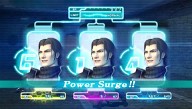 Further to this there are numbers that also cycle with the images, if two matching numbers pop-up your matching numbered Materia/Accessory will power up, and if all three wheels hit a 7, then Zach is leveled up. It is a really unique take on special abilities and leveling, and since this is a handheld title, it just works. The action is so fast and common that this freeing up of resource management adds to the enjoyment of the game. The DMW is also attached to your characters emotional state: the happier/more excited you are, the more often you see matches on the wheels. Occasionally, when you see a match, you are also treated to little video segments that further show the relationships between the characters. These moments were some of my favorite in the game and actually explain some attacks and relationships in a surprisingly effective way.
Further to this there are numbers that also cycle with the images, if two matching numbers pop-up your matching numbered Materia/Accessory will power up, and if all three wheels hit a 7, then Zach is leveled up. It is a really unique take on special abilities and leveling, and since this is a handheld title, it just works. The action is so fast and common that this freeing up of resource management adds to the enjoyment of the game. The DMW is also attached to your characters emotional state: the happier/more excited you are, the more often you see matches on the wheels. Occasionally, when you see a match, you are also treated to little video segments that further show the relationships between the characters. These moments were some of my favorite in the game and actually explain some attacks and relationships in a surprisingly effective way.
The game is fast paced due to the strong game mechanic, and while all the encounters are random (to an extent, as there are noticeable points where you know certain encounters are supposed to happen), they never become annoyingly common. Because much of your Materia and items come from these encounters, you generally have no complaints when a fight is triggered. The fact that transitioning into and completing battles is so quick means you have a system that is fun and painless to play.
This title also features a mission-based system that is accessible from the save points. These missions are generally story independent (some are made available when certain events occur in the game) and are bit size encounters you can complete whenever you want. These hundreds of missions really don’t add much to the story, but in some cases do provide unique Materia, summons, and characters for the DMW. The missions generally all revolve around clearing an area though some are varied with just boss fights or battles against hoards of enemies. They are quite addicting and you often find yourself digging into the missions for hours before you realize there is still a full game to play.
While the missions are quite fun and at times add some background to characters (there are a number of missions based around a pre-teen Yuffie that are quite funny), as a general rule, they are very generic. They start with a very brief description, and even when you complete an entire series, you are given no feedback to tell you that something has been accomplished. If they do another game in this vein (a game version of Advent Children on the PSP would be nice), more time and care to flesh out the missions would be appreciated as the missions are the only bland part of the game in general.
The missions have an interesting side effect though. If you really get into them, you will find that your character quickly out-levels the main game. I found the missions quite challenging at a certain point, but because of how many I have done, the main game become very easy. My character had such powerful Materia and attacks that even boss fights became quick wins. While this did not detract from the experience, I have to wonder at the balancing and question if the developers had wished they had added adaptive AI to the game, such as we saw in last year’s Mass Effect.
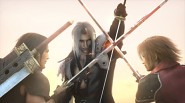 Graphically, this is a stunning game, as the characters, environments and creatures are all represented in a fidelity that makes you doubt that this is a handheld title. The story is shown in three ways, the first of which is the main game play engine that has you traveling and battling your way through the world. The in-game cutscene engine is the second method. It showcases more detail and a closer view of the characters and is very reminiscent of the Kingdom Hearts style.
Graphically, this is a stunning game, as the characters, environments and creatures are all represented in a fidelity that makes you doubt that this is a handheld title. The story is shown in three ways, the first of which is the main game play engine that has you traveling and battling your way through the world. The in-game cutscene engine is the second method. It showcases more detail and a closer view of the characters and is very reminiscent of the Kingdom Hearts style.
The final way is the CG cutscenes. These are once again some of the best in the industry and are thoroughly amazing. On the PSP screen, we are looking at Advent Children quality CG and some of the scenes literally took my breath away. It should also be noted that the CG characters look remarkably like their in-game counterparts. Final Fantasy X was a huge disaster in that regard with the CG and in-game characters generally not matching at all. All put together, the game is amazing to look at and since I have a PSP-2000, I tried the game outputting via component to my TV and it held up very well at a larger scale.
What I really noticed and appreciated in this game is the art style and design elements of the game. Since Final Fantasy VII was from so long ago (10 years), there was a general look and feel of the universe. Advent Children fleshed it out substantially and this game represents that look in a great way. As Zach progresses through the game, his uniform, hair and appearance change to suit what has happened to him.
Other characters also undergo changes. It is a really nice touch and a great change from the relatively static character models we have seen in other Square Enix titles. The world around Zack is filled with amazing amounts of tiny details, and while it is not very interactive, you can at least look at it and feel that it is a real world. The team responsible should be congratulated on the care they took with this world. I am sure there were lots of eyes on this project and high amounts of pressure to ensure the world was consistent and they definitely delivered.
 On the audio front, Crisis Core also performs at a top notch level. Much of the game’s story moments are fully voiced ,and aside from a slight dislike I had of Aerith’s voice for no reason at all ,everyone sounds great and suits their character. Sephiroth is brooding and melancholy, Genesis is mysterious and aggresive, Angeal is sombre and noble and Zach begins full of life and zest and ends sounding like he is being weighed down by his problems and worries. The music (especially the theme played in Aerith’s church) is very good and brings across the tone of the Final Fantasy series. I felt shivers when I first heard Sephiroth’s anthem playing. The developers knew that song was synonymous with the series and used it at different times to great effect.
On the audio front, Crisis Core also performs at a top notch level. Much of the game’s story moments are fully voiced ,and aside from a slight dislike I had of Aerith’s voice for no reason at all ,everyone sounds great and suits their character. Sephiroth is brooding and melancholy, Genesis is mysterious and aggresive, Angeal is sombre and noble and Zach begins full of life and zest and ends sounding like he is being weighed down by his problems and worries. The music (especially the theme played in Aerith’s church) is very good and brings across the tone of the Final Fantasy series. I felt shivers when I first heard Sephiroth’s anthem playing. The developers knew that song was synonymous with the series and used it at different times to great effect.
During the game, you hear many other audio cues such as the voice announcing ‘combat mode initiated’ to the quick burst of the Final Fantasy victory theme when you complete a mission. The audio is used intelligently to further the game and add atmosphere. While that sounds simple and logical, it is often not done properly in a handheld title. Audio is also very well mixed with proper sound levels utilized to take advantage of the PSP’s audio output functions.
Crisis Core – Final Fantasy VII had a huge pedigree to live up to and also had to overcome the disappointment everyone felt with Dirge of Cerberus. I can easily say it met the challenge. This is an engaging game with a great story and a character I now rank as one of my favorite in the entire Final Fantasy series. The game mechanics, atmosphere and stunning cinematics all tie together to make this one of the best games on the PSP, and that is saying a lot considering the recent flood of triple-A titles on it recently. Do yourself a favor: pick this game up, revisit the beloved world of Final Fantasy VII and prepare for a great ride.
Crisis Core – Final Fantasy VII is rated T (Teen) by the ESRB for Blood, Mild Language, Mild Suggestive Themes and Violence.
 Blogcritics The critical lens on today's culture & entertainment
Blogcritics The critical lens on today's culture & entertainment


